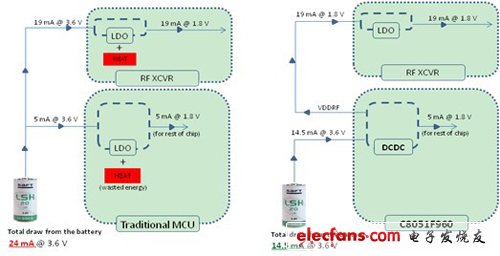Fuwei Group launched Silicon Labs low-power MCU C8051F9XX for unprovoked medical care solutions. This series of chips has been widely used in RFID tags, water and gas meter measurement, sensor interfaces, energy collection, alarm systems, smoke detection, and handheld medical care systems. C8051F9XX is currently the most power-saving MCU in the industry, with a minimum standby power consumption of 10nA, effectively increasing battery life. C8051F9XX has built-in 12Bit AD, which can fully meet the AD requirements of the medical system and greatly reduce the cost of customers.

In the general operation mode, the 8-bit F9xx microcontroller can reach the industry's lowest current consumption to provide the lowest system-level power consumption in the embedded market. This microcontroller with excellent power efficiency provides the lowest operating mode current consumption (160µA / MHz), which can greatly save power during system operation. In sleep mode, this microcontroller consumes the lowest current in the industry, whether it is operated with real-time frequency and low-voltage detection circuit (300nA) or without real-time frequency and low-voltage detection circuit (10nA) Under, all the contents of RAM can be maintained.
Remote autonomous health management system
This project successfully constructed an intelligent real-time remote medical care system. Using the C8051F9XX to collect blood pressure and blood oxygen, combined with the most popular Iphone as the data receiver, providing real-time monitoring, automatic file storage and historical data preview, etc. The Iphone can also transmit data to a remote server in real time through the network To achieve remote real-time physiological monitoring and analysis, the server also has file storage and analysis report output. This project also successfully applied ultra-low power MCU, real-time prosecution, to achieve the purpose of "physiological monitoring invisible, health care in life".

Long-term care system remote health care service
Long-term care system remote health care services include three types: home mode, community mode and institution mode. The home model takes care of chronic diseases as the service target, and is evaluated by the long-term care service maintenance or care institution, and uses remote care for health management; the institutional model takes the long-term care service maintenance or care institution as the service patient, providing blood pressure , Heartbeat, blood sugar, and electrocardiogram and other remote physiological measurements, abnormal value reminders, health management, disease risk assessment analysis and early warning, remote video, health education and care, referral to medical and other services.

C8051F9XX Features
Higher voltage conversion efficiency
In order to increase the efficiency of CMOS circuits and reduce their power consumption, chip designers usually use the smallest size and practical components to build integrated circuits. Generally, embedded processors and RF transceivers are designed with 0.18µm, 0.13µm or even 90nm. A key indicator for reducing the power consumption of components is to reduce the internal operating voltage, which in turn reduces CVf switching losses.
Even if the battery-powered component supports a 3.6V supply voltage, the component can usually work at a very low internal voltage.
Almost all components on the market integrate a low-dropout regulator (LDO). When the input voltage is 3.6V, the output voltage is adjusted to a very low value, usually 1.8V or lower. In other words, a linear regulator with an input voltage of 3.6V and an output voltage of 1.8V will produce 50% conversion efficiency. Obviously, as the output voltage drops, this efficiency will become worse.
Higher-order embedded controllers, such as the C8051F960 MCU in Figure 2, incorporate a switching regulator that is more efficient than LDO controllers. In most cases, the switching efficiency of this component can be as high as 85%, which can reduce the overall current from the battery and extend the battery life.

In this way, the current RX power arrangement can be greatly reduced. In other words, the battery current consumed by the radio receiver is about 62.5% of the DC-DC buck converter (not just LDO). The practical result of using this method is to reduce the RX current power consumption arrangement.

With this change, we are close to meeting the requirements of the new RX power arrangement (such as shown in Figure 3: from 30% to 19%, although the goal is to reduce to 18%). Next, we need to continue to optimize other operating modes in the system.
Lower sleep mode power consumption
Typically, battery-powered meters are in low-power sleep mode 99.9% of the time. Therefore, it is very important to reduce the power consumption of the sleep mode circuit as much as possible. A few years ago, by using a 32.768 kHz crystal to drive a low-power wake-up time at 3.6V, the current consumption was as low as about 1µA. With further optimization and improvement, the components only require approximately 700 nA at the same voltage to use the same function. Although the final savings (net savings) is only 300nA, in fact the savings are completely effective, this value can be directly subtracted from the power arrangement.

Using low-power sleep mode components, you can reduce the sleep mode arrangement from the previous 8% to 5% (as shown in Figure 4), you can achieve the design goals. However, this is just to achieve the goal, and does not exceed the goal, still need to make further improvements to achieve the overall design goals. The last important point is how to reduce the power consumption in working mode.
Non-Woven Material Wet Wipe,Cleaning Use Non-Woven Wipe,Non-Woven Wet Wipes,Disposable Non-Woven Wipes
Miraclean Technology Co., Ltd. , https://www.mrccleanroom.com